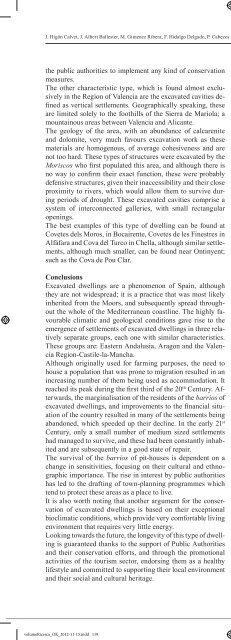habitat rupestre.pdf - Società Friulana di Archeologia
habitat rupestre.pdf - Società Friulana di Archeologia
habitat rupestre.pdf - Società Friulana di Archeologia
Create successful ePaper yourself
Turn your PDF publications into a flip-book with our unique Google optimized e-Paper software.
J. Higón Calvet, J. Albert Ballester, M. Gimenez Ribera, F. Hidalgo Delgado, P. Cabezos Bernal, H. Barros Costathe public authorities to implement any kind of conservationmeasures.The other characteristic type, which is found almost exclusivelyin the Region of Valencia are the excavated cavities definedas vertical settlements. Geographically speaking, theseare limited solely to the foothills of the Sierra de Mariola; amountainous areas between Valencia and Alicante.The geology of the area, with an abundance of calcareniteand dolomite, very much favours excavation work as thesematerials are homogenous, of average cohesiveness and arenot too hard. These types of structures were excavated by theMoriscos who first populated this area, and although there isno way to confirm their exact function, these were probablydefensive structures, given their inaccessibility and their closeproximity to rivers, which would allow them to survive duringperiods of drought. These excavated cavities comprise asystem of interconnected galleries, with small rectangularopenings.The best examples of this type of dwelling can be found atCovetes dels Moros, in Bocairente, Covetes de les Finestres inAlfáfara and Cova del Turco in Chella, although similar settlements,although much smaller, can be found near Ontinyent;such as the Cova de Pou Clar.ConclusionsExcavated dwellings are a phenomenon of Spain, althoughthey are not widespread; it is a practice that was most likelyinherited from the Moors, and subsequently spread throughoutthe whole of the Me<strong>di</strong>terranean coastline. The highly favourableclimatic and geological con<strong>di</strong>tions gave rise to theemergence of settlements of excavated dwellings in three relativelyseparate groups, each one with similar characteristics.These groups are: Eastern Andalusia, Aragon and the ValenciaRegion-Castile-la-Mancha.Although originally used for farming purposes, the need tohouse a population that was prone to migration resulted in anincreasing number of them being used as accommodation. Itreached its peak during the first third of the 20 th Century. Afterwards,the marginalisation of the residents of the barrios ofexcavated dwellings, and improvements to the financial situationof the country resulted in many of the settlements beingabandoned, which speeded up their decline. In the early 21 stCentury, only a small number of me<strong>di</strong>um sized settlementshad managed to survive, and these had been constantly inhabitedand are subsequently in a good state of repair.The survival of the barrios of pit-houses is dependent on achange in sensitivities, focusing on their cultural and ethnographicimportance. The rise in interest by public authoritieshas led to the drafting of town-planning programmes whichtend to protect these areas as a place to live.It is also worth noting that another argument for the conservationof excavated dwellings is based on their exceptionalbioclimatic con<strong>di</strong>tions, which provide very comfortable livingenvironment that requires very little energy.Looking towards the future, the longevity of this type of dwellingis guaranteed thanks to the support of Public Authoritiesand their conservation efforts, and through the promotionalactivities of the tourism sector, endorsing them as a healthylifestyle and committed to supporting their local environmentand their social and cultural heritage.Fig. 11-12 Covetes de Les Finestres; Alfáfara: Detail and cross-section119volumeRicerca_OK_2012-11-15.indd 119 16/11/2012 15:02:09
















